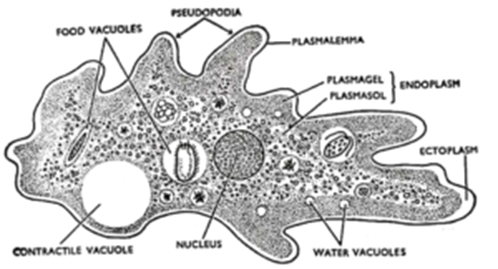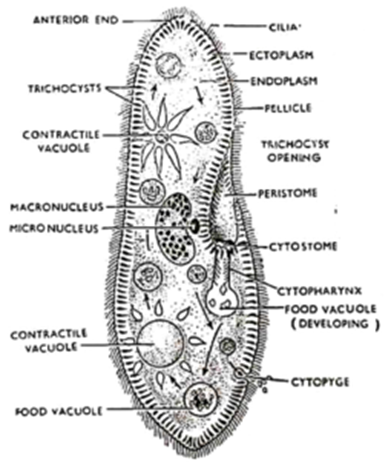In this article we shall study about movements and locomotion.
Movements:
The act of changing position or place by one or more of its parts is called a movement. Movement is one of the significant features of living beings. Animals and plants exhibit a wide range of movements. The study of movements is called kinesiology (Greek: Kinein = to move and logos = to study).
Plants cannot move from one place to another as animal do. The growth of a plant is a movement. The closing of leaves of touch me not plant is a movement. Animals exhibit a wide range of movements. Streaming of protoplasm by forming pseudopodia in the unicellular organisms like Amoeba is a simple form of movement. Movement of cilia (as in paramoecium), flagella (as in bacteria) and tentacles (as in hydra) are shown by many organisms.
Advantages of Movements to Animals
- Movements of limbs or appendages help in locomotion. e.g. wings for flying, fins for swimming, legs for walking, etc.
- Movement of limbs and body parts for capturing, holding and ingestion of food. e.g. movements of tentacles, hands, jaws, tongue, etc.
- Movement of limbs, appendages and body trunk helps in adjusting body posture against gravity, for rest and relaxation.
- Movement of body parts for collecting information. Movement of eyeballs, external ears, antennae, tentacles.
- Movements also result in facial expressions and gestures.
Movements in the Human Body:
- The rhythmic beating of heart for circulation of blood
- Peristalsis in the alimentary canal to propel food forward.
- Movement of thoracic region (rib cage) and diaphragm for breathing
Movements at Different Levels:
- At the molecular level: The zigzag or Brownian movement of molecules in the cytosol (cytosol is the aqueous component of the cytoplasm of a cell, within which various organelles and particles are suspended). This movement is also called as a Brownian movement.
- At the cellular level: At this level, there is a movement of the cell itself. e.g. movement of amoeba by forming pseudopodia, movement of sperms (male gametes), movement of paramecium using cilia, movement of flagellated bacteria.
- At organ level: Movement of eyeballs, the beating of the heart, inflation and deflation of lungs during breathing, movement of tentacles, contraction, and relaxation of muscles, etc.
- At organism level: swimming of fishes in the water, flying of bird, running, walking are examples of organism-level movement.
Plants show molecular level, cellular level, and organ level movements. Animals show all the four types of movements. Organism level movement is a characteristic of animals.
Types of Movements:
Cells of the human body exhibit three main types of movements, namely, amoeboid, ciliary and muscular.
Amoeboid movements:
Amoeboid movement is shown by unicellular animals and cells which are amorphous i.e. not having definite morphology or shape. It is crawling movement by the formation of pseudopodia. Pseudopodia are formed by the streaming of protoplasm in the cell. Cytoskeletal elements like microfilaments are also involved in the amoeboid movement.
Example: Amoeba, macrophages, and leucocytes in blood exhibit amoeboid movement.
It is due to cytoplasmic flow. The cell forces the fluid inside it by pulling the cell forward forming false foot called pseudopodia.

To form the pseudopodia the cytoplasm within the cell undergoes a series of biochemical changes that alter the viscosity of the protoplasm within different areas of the cell. Due to some stimuli say that of food, the viscosity of protoplasm near the food end decreases and it almost becomes watery. In this condition, the protoplasm is referred to as plasma sol. While the viscosity of protoplasm at the far end increases and protoplasm becomes thick. In this condition, the protoplasm is called as plasma gel. This plasma gel acts as a wall and creates pressure on plasma sol. Under this excess pressure, the plasma sol has no choice but to move forward.
Ciliary Movements:
Ciliary movement occurs in most of our internal tubular organs which are lined by ciliated epithelium. The coordinated movements of cilia in the trachea help us in removing dust particles and some of the foreign substances inhaled along with the atmospheric air. Passage of ova through the female reproductive tract is also facilitated by the ciliary movement. Paramoecium moves in water using cilia.

Flagellar movement is similar to ciliary movement and can be seen in Euglena.

Muscular movements:
In vertebrates, locomotion depends on the bones or endoskeleton and muscles attached to them. These muscles are called skeletal muscles. The bones and skeletal muscles together form musculoskeletal system. The movements of the body part are under voluntary control of the central nervous system. Therefore, skeletal muscles are also called voluntary muscles.
Locomotion
The voluntary movements which result in a change of place or location, then such movements are called locomotion. The movements associated with walking (as in man), running (as in horse, deer, cheetah), climbing (as in monkey), flying (as in birds, bats and insects), swimming (as in fish), hopping (as in rabbit, frog), creeping (as in earthworm), crawling (as in snake), gliding (as in flying lizard) results in locomotion.
There are animals like sponges, corals, some echinoderms and tunicates are fixed at one place to the substratum. The organisms which move from one place to another are called motile.
Paramoecium uses cilia for locomotion and as well as for the movement of the food through cytopharynx. Hydra uses is tentacles for capturing the food as well as for locomotion. We use limbs for locomotion and for doing many other functions like throwing, catching, holding, etc. Thus same organs or body parts are used for different purposes. Hence the movements and locomotion should be studied simultaneously.
All locomotions are movements but the converse is not true. The method and extent of locomotion in an animal depends on its habitat and demand of the situation.
There are animals that move on land (terrestrial), in the air (aerial), in trees (arboreal), and in the water (aquatic). Each of these environments requires a different type of movements for locomotion and each environment has its own pros and cons. Animals on the ground have to worry about friction, animals in the air have to worry about gravity, and animals underwater have to worry about buoyancy.
Most of the animals move in search of food, shelter, mate, suitable breeding grounds, favourable climatic conditions or to escape from enemies/predators.
Distinguishing Locomotion and Movement:
Locomotion involves the movement of the whole body from one place to another place. While movement includes the change in shape, size and direction of body parts with respect to the body axis. It may or may not involve a change of body position.
External body parts are involved in locomotion while external as well as internal body parts are involved in a movement.
All locomotions are movement but all movements are not locomotions.